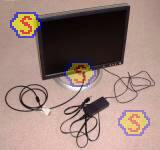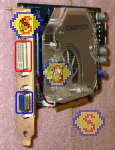


|
|

|
|
|
||
Flat Panel LCD Monitor
Flat panel displays are becoming a viable option. They are still more expensive than CRT models, and CRT models do the job quite well, so I would not put a flat panel display monitor in the "sweet spot", and certainly not the Dell Ultrasharp 2001FP 20.1" monitor that I'm using with My Super PC.
On the other hand, it's fair to say that you get quite a bit more viewing pleasure out of a flat panel LCD monitor. Even though CRT's are quite good, the viewing quality on a flat panel LCD monitor is just amazing. And since a monitor is one component of a PC that lasts a very long time, you may decide the extra money is worth it. One thing that helps narrow the cost difference is that a flat panel LCD monitor uses much more of the viewable surface than does a CRT monitor. For example, a 17" flat panel display monitor has about the same amount of screen real estate as a 19" CRT monitor.
Here is the Dell Ultrashap 2001FP 20.1" monitor in My Super PC.A flat panel LCD (FPD) monitor is not for everyone, but not necessarily because of cost. FPD's are not as good as CRT monitors at maintaining consistent quality at every screen resolution, and at some screen resolutions things will definitely look distorted and worse than they would look on a CRT. So those into computer art or web design may find a CRT a more appropriate choice.

Besides cost, another important consideration in determining what size of FPD would be best is to know its "native resolution". This is the resolution at which screen images look their sharpest. Expect a 15" FPD to have a native resolution of 1024x768. Expect 17" and 19" FPD's to have a native resolution of 1280x1024. And for a 20" FPD like the one I'm using, expect a native resolution of 1600x1200. Getting a size FPD whose native resolution matches the screen resolution you normally use ensures high viewing quality. But any screen resolution in-line with the FPD's aspect ratio works provides nearly the same viewing quality. For example, the aspect ratio of the Dell Ultrasharp 2001FP is 4:3 due to its 16" by 12" screen size. A quality built FPD will have a native resolution in the same proportion as the aspect ratio, such as the 1600x1200 native resolution of the Dell Ultrasharp 2001FP. Other resolutions at the same ratio, such as 1280x960, still look amazing.
It's definitely true that FPD screen images look their sharpest at their native resolution. But it's also true that they look excellent and better than a CRT at some of the other resolutions, but not all. There are some resolutions where the screen images will not be pleasing and will actually look worse than a CRT. The problem with viewing on an FPD that has a native resolution of 1600x1200 is that the images are too tiny for comfortable viewing. Quite sharp, quite clear, and quite tiny. Younger eyes may not find them so uncomfortable.
I use my FPD at both 1152x864 and 1280x1024 resolutions and still find my FPD to be a striking improvement over a CRT. Computer games often set their own screen resolution, but I haven't come across a game yet that didn't look remarkably better on the FPD. The reason viewing is so much better on an FPD instead of a CRT is the greater brightness of the colors and the better contrast. This, in addition to maintaining sharpness and clarity, make the FPD more comfortable for routine tasks, and far more immersive for games.
There are other advantages and disadvantages between FPD's and CRT's that can be considered besides cost and screen clarity. An FPD takes up much less desk space, I'd say less than half the desk space, and that's awesome. Not only is there more room for other things on my desk, but it allows me to place the FPD monitor that much further away so that my eyes don't have to focus on something so close to my face. An FPD is much more portable. A 19" CRT is virtually impossible for many of us to move safely and is bulky to transport, but even the 20.1" FPD I am using could be picked up and transported by anyone using any vehicle. FPD monitors do not do as well as CRT monitors when viewed at sharp angles, but in practical terms a monitor is not viewed at the angle at which the display quality begins to be affected. And the FPD uses less power, but I doubt you'll really notice any difference on your utility bills.
Problems that have plagued FPD's in the past have been largely eliminated. One problem, the ghosting and blurring of images, no longer occurs on quality FPD's. I use mine for top-tier gaming frequently and I've never seen these problems. Another problem, getting a FPD with a faulty pixel, used to be almost expected but is now unusual. You should look for faulty pixels when first putting the monitor in use by using a utility like the free version of DisplayMate.
The FPD should have a digital video connector, called a DVI (Digital Video Interface) connector. Many FPD monitors also support the standard D-sub (VGA analog) connector used by CRT monitors. The more video input connectors the monitor supports, the handier it might be. In addition to these two types of input connectors, the Dell Ultrasharp 2001FP also comes with composite and S-Video input connectors. It even includes a USB hub.
Viewing quality is maximized when the FPD is connected to either a DVI-D or DVI-I connector on the video card. DVI-D connectors support digital only monitors. DVI-I connectors support both digital and analog monitors. A DVI-A connector supports analog only monitors. For example, the DVI connector on both the ATI Radeon 9600 XT and the ATI Radeon 9800 Pro is DVI-I. The ATI All-In-Wonder models, such as the ATI All-In-Wonder 9600 Pro, do not have a DVI connector at all. Viewing quality is often still quite good when the FPD monitor is connected using the D-sub connectors on both the video card and FPD. In fact, many people claim it appears to be just as good as when the FPD is connected using DVI connectors. In the photo of the Chaintech GeForce 6600 GT below, the D-sub connector is circled in blue and the DVI connector is circled in red.Two characteristics of a FPD monitor are its Contrast Ratio and Response Time. These sound like useful characteristics, so it would be nice if they could be used at face value to tell something about the monitor, or at least to compare one FPD to another. In practice, however, the values cannot be relied upon to guarantee anything on the positive side. On the negative side, you can be sure it's a low quality FPD monitor if the Contrast Ratio is less than 400:1 (such as 200:1), the Response Time is greater than 25ms (25 milliseconds), or the Color Depth is 6-bit (it should be 8-bit). A 6-bit Color Depth which is "dithered" is still low quality. What it comes down to with a flat panel LCD monitor is that you should buy a brand that is known to be of high quality. Dell, Viewsonic and Samsung all make high quality FPD monitors.
